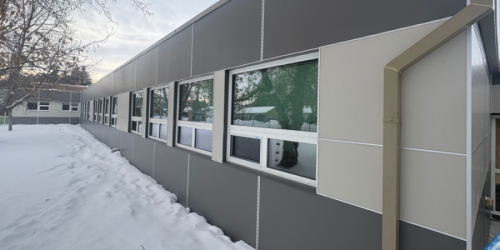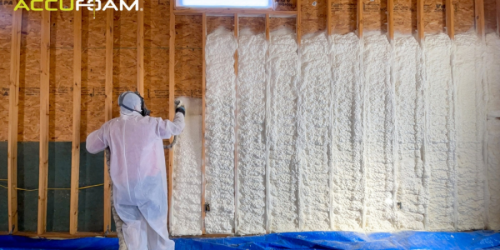Q&A Forums
Foaming an attic with existing insulation Post New Topic | Post Reply
| Author | Comments |
|---|---|
|
bob brown
Posted: May 19, 2009 02:53 PM
|
Foaming an attic with existing insulation
I have a customer that wants to keep the existing blown-in insulation left in the floor of attic, then wants spray foam sprayed to the underside of the roof deck. They have HVAC equipment in the attic as well. Will this be a problem?
|
|
mason
Posted: May 19, 2009 04:57 PM
|
Yes, remove the insulation on the floor of the attic it is working against the insulation on the underside of the roof deck. When doing an unvented attic, you want the natural air infiltration from the interior spaces to go into the attic. This keeps the attic space typically within 7-8 degrees of the interior space. But, if you leave the insulation on the floor of the attic it will keep the attic closer to the outside temperature. |
|
jimcoler
I have over 10 years of experience specifying and installing open and closed cell spray foam. I've sold my business but I'm still selling for the new owners and consulting on large and custom specific jobs. I've expanded my knowledge into t Posted: May 19, 2009 09:22 PM
|
This is another point that Mason and I may disagree on from a building science standpoint. I would state that it shouldn't make any difference whether you leave it or remove it - especially if you have ductwork in the attic which is typically leaky. The argument is typically that the moisture within the air will condense in the attic. But if we put building science principles to practice, in order for condensation to occur, you need a cold surface in close proximety with warm moist air. The warm air drops the heat to the cold surface (which is below the dewpoint) and the moisture gets left behind on the surface. So, if you spray the underside of the roofdeck with an adequate thickness of foam, where's the cold surface? There isn't one - the surafce of the foam is approximately the same temperatures as the air within the attic. This is especially the case with duct work in the attic which tends to leak and condition the attic more so. If this was such a big concern, then why are new buildings allowed to have a closet on an outside wall? What's the difference? It's an enclosed air space with extra insulation (clothes)and little to no connectivity to the house. Why don't we see wide spread issues in closets? Typically when I see an issue in a closet it's due to cold air leakage into the closet are or a lack of insulation in the exterior wall or both. It's not the case when there is good insulation and an air barrier product on the outer most layer. So, why can we use insulation on interior walls (primarily for sound) with different zones. The empty nmesters typically close off bedroom heating and AC ducts and they aren't seeing massive issues! So it looks like this may be another issue Mason and I disagree on and I'll let you decide for yourself. Jim Coler www.coler.com |
|
mason
Posted: May 20, 2009 07:45 AM
|
Jim, The insulation on the floor of the attic will be somewhat effective (about 50% of its rated R value in separating the interior temperature from the attic temperature. While the foam is pretty effective by itself, the insulation on the floor will lesson the effectiveness of it by not allowing the heat to seep into the attic in the winter and conversely allowing the heat to build in the attic during the summer. Both factors will make the attic warmer in summer and cooler in winter. I agree the foam in sufficient thickness will prevent condensation, I am saying the foam's energy efficiency will be affected. |
|
jimcoler
I have over 10 years of experience specifying and installing open and closed cell spray foam. I've sold my business but I'm still selling for the new owners and consulting on large and custom specific jobs. I've expanded my knowledge into t Posted: May 20, 2009 09:18 AM
|
Mason, Heat transfer is directly related to the temperature difference from one side of the insulation to the other. The effectiveness of the spray foam is not degraded by a separate layer of fiberglass, it's actually the exact opposite. If you decrease the temperature difference from one side to the other of the foam, it will have less heat loss. If you have 6" of Fg in the attic floor it may be stated as an R-21, but we all know that it performs much less so lets say it performs at R-14 (I'm feeling gratious today for the FG guys). So you have R-14 on the ceiling, the air space in the attic will act as some insulation value but there will also be convective loops occurring in this space so let's just ignore the air space even though it does add some overall value if it's not a moving air space. Then we have about 6" of open cell foam on the underside of the roof which is about R-22 (averaged out based on mfgrs used). So we have a total of R22(foam)+R14(FG) which gives usan R-36 - excluding any value for the air space. How is this less efficient in total value than only the R-22 foam? It just doesn't make sense. If you lower the temperature to the inside of the foam and make it closer to the outside temperature, then this makes the insulation more efficient at slowing the heat transfer. This si yet another good debate which I've run into that I've heard some off the wall conclusions including "It will Rain in your attic" if you leave the FG. We've done it and had no problems - to the contrary, we have customers raving about the results. Jim Coler www.coler.com |
|
Posted: May 20, 2009 12:19 PM
|
Out of curiousity I ran some of the simplified excel-based heat loss calculations/temp gradient profiles that I have here at work...and I still cannot figure out how you (Mason) come up with an efficiency loss. I assume we are having some miscommunication here - because the science should't be ambiguous. If you leave the fiberglass in place, the BTU's lost (heating season) or gained (cooling season) are less...therefore, less expensive to run your house. No matter which way I run the calc's - more insulation is better - and then it is just a matter of managing where the dew point occurs. What am I missing here? |
|
Corey Degetaire
Posted: May 20, 2009 01:04 PM
|
I thought that one of the benifits of foam was that it was healthier than fiberglass, so if there is no major difference if it stay or goes then why wouldnt you want to remove the fiberglass from the attic floor. I always suggest to my clients that it be removed. At one time it was listed as a possible carcinogen!! |
|
jimcoler
I have over 10 years of experience specifying and installing open and closed cell spray foam. I've sold my business but I'm still selling for the new owners and consulting on large and custom specific jobs. I've expanded my knowledge into t Posted: May 20, 2009 02:00 PM
|
You're correct - California released a study showing it is a carcinogen back in the late 1970s, but for some reason I saw a statement that this report was rescinded with no further explaination.... There are pros and cons to leaving it vs. removing it. If it's been there for many years, the formaldehyde that was in it has probably already outgassed as much as it's going to. By removing it, you're disturbing it and causing the fibers to be more airborn. You're also breaking many of the fibers causing them to be light and more airborn. In most cases you would also have to drag bags of it through the house and the bags can be stagged coming through the hatch and then you've released more fibers into the living space of the house. So, if you can install the foam and disturb the fiberglass as little as possible, it's probably not going to do any additional harm. Good discussion. Keep it up! Jim Coler www.coler.com |
|
mason
Posted: May 20, 2009 02:06 PM
|
I haven't run the numbers but the attic temperatures should be either cooler in winter or hotter in summer due to the insulation on the floor of the attic insulating the interior of the house from the attic. I am concerned about heat loss from the duct work and HVAC in the attic which can be significant. It would depend on hot much cooler or hotter the attic is. If there were not HVAC or ducts in the attic I would agree. But I will ask one of my engineering friends to do the calculations. If I am wrong, so sorry for the bad advice. |
|
mason
Posted: May 20, 2009 03:53 PM
|
To explain further. The attic space is insulated two ways. From the interior by the fiberglass with an effective R value of around 17 and from the exterior by the foam with an effective R value of around 24 (5 inches of closed cell). (according to ORNL testing of foam and fiberglass in attics) So in the winter the attic loses heat through the attic ceiling and gains heat through the attic floor. You have to calculate both to get the right attic temperature then determine the heat loss from the vents in the attic My thinking is that the attic will be cooler in winter and warmer in summer and with the HVAC units and ducts in the attic it would lose energy efficiency by having a higher delta T between the attic and the interior spaces. But, I have not done the calculations. If the difference in temperature is only a few degrees, the fiberglass wouldn't hurt but if it is more than 15 degrees difference it would. |
|
mason
Posted: May 20, 2009 04:07 PM
|
I received this info from Roger Morrison who is more knowledgeable about moisture and heat transfer calculations than I am. Mason: The primary problem with leaving the fiberglass on the attic floor is that the building code (and the building science behind it) assume that there is sufficient heat and moisture transfer through the attic floor (ceiling) to condition the attic. There are two problems with leaving the fiberglass intact: 1. The effect of the attic floor insulation will cause the surface of the SPF insulation under the roof deck to be cooler and possibly below the dew point (resulting in condensation); and 2. If there is a vapor retarder associated with the fiberglass insulation, there will be no mechanism to remove moisture from the attic. A solution to both these problems would be to create air circulation in the attic using the HVAC system/duct work. However, this then defeats the effect of the attic floor insulation AND would connect the attic space with the occupied space and, therefore, would necessitate a thermal barrier over the spray foam. Basically, the rule is to remove the attic floor insulation and, especially, the attic floor vapor retarder. As with all rules, there are exceptions but I would not recommend leaving the fiberglass in place without running a WUFI simulation. Please feel free to use this info in any manner you see fit. Roger |
|
bob brown
Posted: May 20, 2009 04:58 PM
|
In the house in question - the existing insulation is blown-in,consisting of mostly recycled newsprint, cellulose insulation without a vapor retarder, there is also a pull-type attic louver system between the living space and the attic - is this enough to add "conditioning" to the attic? |
|
mason
Posted: May 20, 2009 04:59 PM
|
Roger goes on to say the secondary reason for removing the fiberglass is reduce the delta T in the attic from the interior temperatures as I earlier suggested. |
|
Jeff Maxwell
Posted: May 28, 2009 03:28 PM
|
I had this done to my home 10/07. I put temp and humidity recorders in the living area and the attic about 3 months before having the underside of the roof deck sprayed. The temp difference in the heat of the day was interior was 76 deg 50-60% humidity attic was 115-129 with 30-40% humidity. this is with a light grey/silver shingle roof. After the spray 1 year later interior temp at 74 humidity was 55-60%. Attic was 85-92 with humidity staying less than 5 points different from living area. these are during the hottest part of the day. I'm in south louisiana where outside temps are 90+ humidity 70-90%. and this was with leaving R-30 in the ceiling. |
|
mason
Posted: May 29, 2009 07:29 AM
|
Good information. The temperatures are consistent with what I would expect from leaving the fiberglass on the floor of the attic. Did you happen to check the winter temperatures and humidity as well? |
|
Jeff Maxwell
Posted: May 30, 2009 04:37 PM
|
Hi Mason I have almost a full years worth of data from 3 different recorders, outside, inside and attic. Its about 1700kb in excel format, if you would like a copy of it drop me a email at jmax1977@yahoo.com and I will send it to you. I started recording at the end of July 07 Had the insulation installed in late Oct. 07 Don't recall the exact date, and stopped recording in July 08. I'm still recording now but have not downloaded the data from July 08 till now. If you would like the latest data let me know and I will download it and can send you a copy when I get it done. The recorders take Temp, Humidity and Dew Point. |
|
mason
Posted: May 31, 2009 12:35 PM
|
Thanks, will do, appreciate the data. |





























